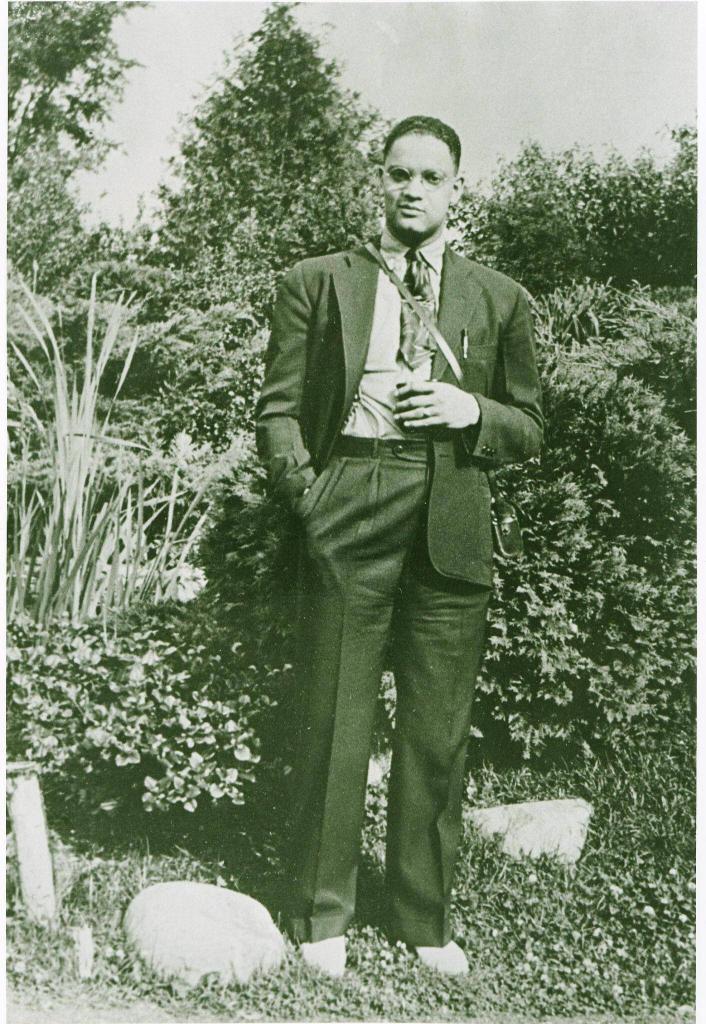
Saxophonist, Joseph Robert St. John had a thirty-year career in Manhattan and Detroit. His New York band battled the great Chick Webb Orchestra and shared a stage with Duke Ellington, Cab Calloway, and King Oliver. For five years, {1929-34} Joe navigated his band through the turbulent waters of the N.Y. music world. In 1934, he was forced by an intense personal situation to abandon the Magic of Manhattan. He headed West, stopping overnight in Detroit.
Detroit was described as “The Paris of the Midwest,” but to Joe it was a guaranteed career-killer, “out in the sticks,” a place with cars but without record companies. He was welcomed by Detroit’s musicians in a jam session and decided to stay. Joe changed his name to “Joe Norris” and told nobody his secret. He quickly found work, joined A.F.M. Local 5, and organized his own band. He had “Manhattan magic” and it showed. Norris flourished in Detroit and grew to love his adopted hometown.
After WWII, he struggled to make sense of the many societal and musical changes taking place. When Bebop emerged, Joe, like many older players, resented it. Norris struggled against alcoholism most of his adult life. The disease strangled up his mind and eventually ended his music career.
After he put his tenor away, Joe’s creative nature blossomed in other areas. He died in 1994, bitter about many things, but not the music he created, nor the musicians with whom he created it.
This is a remembrance of my friend.
One of the biggest thrills in Joe St. John’s life was earning the admiration of bandleader Chick Webb. They met in a 1933 “Battle of the Bands” event at the Apollo Theater in Harlem. St. John called it,
“one pleasurable incident in my life that I will never forget. My band played a battle of music with Chick Webb’s band. My band did not; I repeat, DID NOT win the battle. “After all,” he continued, “Chick Webb had the second-best jazz band in the country. I am proud of the fact that we were there in the first place!” Webb complimented St. John’s band on their sound and arrangements, all of which were penned by Joe. Webb gave Joe a few Fletcher Henderson charts in exchange for some of St. John’s.
Born in 1908 in Newark, New Jersey, Joe was exposed to music at a very young age. “I am from a musical family,” he declares. “My mother subbed in two local dance bands. I used to sit on the floor when they rehearsed and listen.”
The “musical” part of Joe’s family came from Clara’s (his mother) side. One of her sisters and her husband led the Keystone Jazz Band, based in Ansonia, Connecticut. Joe would work with them while he was attending South Side High School in Newark. Clara taught grammar and music at a grade school in Camden, an eighty-five-mile journey. She was eventually able to secure work in Newark public schools teaching piano. Joe started taking piano lessons from his mother when he was seven. “I played Classical music, I had over a hundred pieces of sheet music songs.”
It requires considerable skill to play Classical (European) music, or Classic Rags, for that matter. Joe was living in the Northeast and may have been less exposed to Ragtime than someone living in the Midwest or the South. St. John developed into a proficient pianist under his mother’s tutelage.

Most African American musicians Lars Bjorn and I interviewed had come to Detroit from the South. St. John’s family, through his father’s bloodline, had lived in Connecticut for generations. The earliest print reference I could find was from 1808. Clara’s parents were from the South and first met in Washington, D.C., where they married in 1880. They moved to Ansonia, Connecticut, before 1900.
Joe’s dad, also named Joseph Robert St. John, is listed in Census forms as ‘day laborer’ or ‘chauffeur.’ Clara Virginia St. John is listed as a ‘teacher’. The family moved several times between 1905-1930, always landing in Essex County. Some areas in which they lived were racially mixed. Other occupations in these areas were ‘laborer,’ ‘seamstress,’ ‘piano mover,’ and ‘servant.’
The St. John family had a greater degree of freedom than Southern Blacks. Joe was fully aware of the lynchings and other atrocities inflicted upon members of his race in the South and vowed to never go below the Mason-Dixon Line. In fact, Joe never went further south than Detroit.
When he had become proficient on the keyboard, St. John became interested in other instruments. He was gifted a tenor banjo around 1923 when he was fifteen and liked its sound. Quickly learning the basics, he wanted to study with a professional. An older musician who befriended St. John knew Clarence Holiday, an established musician from Baltimore who later worked with Fletcher Henderson and fathered Billie Holiday. He arranged for St. John to take weekly lessons. The banjo was his entrée into Newark’s music world. Joe began working with the Keystone Jazz Band. He would play with them intermittently until he joined Earle Howard in 1930.
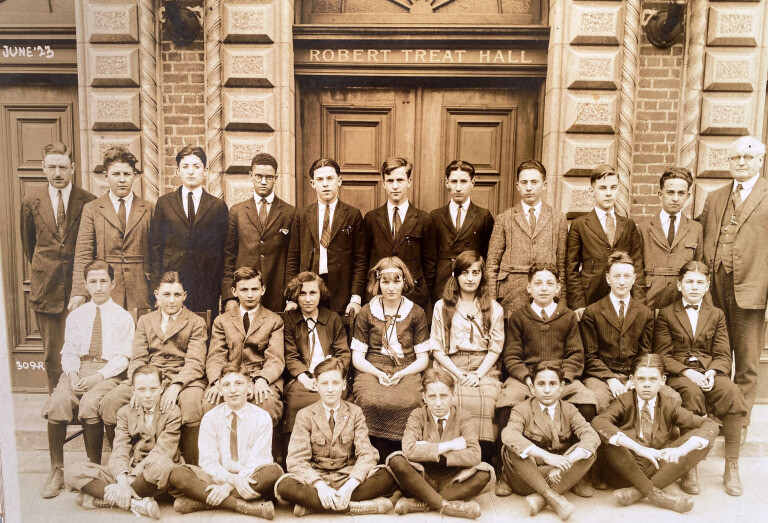
Joe didn’t rely upon his parents for cash. While still in High School, he and a saxophone-playing friend played rent parties every weekend. “We were very popular,” he noted. “We each earned $2.00 and played all night.” Joe admired his pal’s alto sax, but he had big eyes for its larger relation, the baritone saxophone. He bought one on the cheap. “I’ll never forget this,” he said. “within ten minutes, I played the C scale…was music my gift? He asked proudly, his arms open wide, big grin on his face. It takes average musical talent to accomplish that feat in ten weeks. St. John knew he was a musician. Nothing but.
When Joe was a sophomore in High School, Clara bought him an alto sax. She also pushed her son to enroll in Dental College after graduation. St. John was an intelligent young man with serious musical talent. He had no intention of going to College or learning a ‘trade’. Joe faced the same obstacle which had vexed Bix Beiderbecke and countless other young musicians. His parents, especially his mother, wanted their precocious child to ascend and excel in medicine or law. Such a profession would fit neatly into their buttoned-down lifestyle. Joe wanted to make music and hang with his homies. St. John would soon move out, and move on.
When he announced to his parents his intention to quit High School in his junior year, Joe’s mother was deeply disappointed. “She really cried,” Joe added. “She wanted me to be a doctor or something like that. But she should have known (I’d be a musician), she was a piano teacher and played in bands in her younger days. I had heard music all my life.”
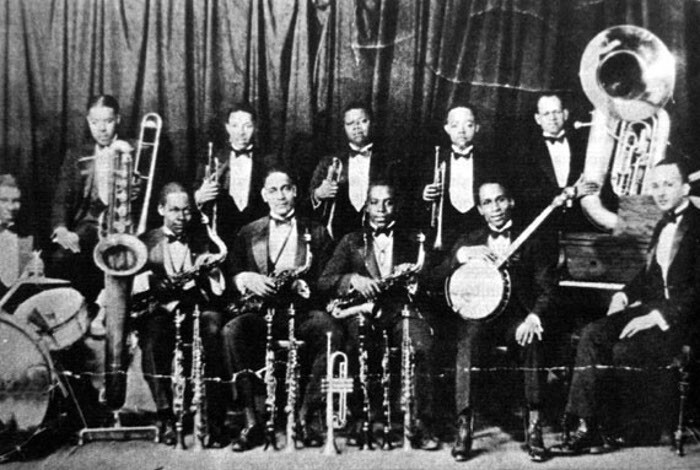
Hearing Fletcher Henderson’s orchestra in person made a massive impression on St. John. When Coleman Hawkins stood up and took a solo, St. John was thunderstruck. He was deeply impressed by Hawkins’ sound and swagger. Joe decided that Henderson had the best band in America, and that he must put aside his other saxophones and get a tenor. He felt a kinship with the instrument; it was like speaking when he played it.

After dropping out of High School in 1924-25, St. John auditioned for a place in the Orpheum Theater pit band, and got the job. The Orpheum was located in downtown Newark. “I played in the Orpheum for more than a year,” Joe recalled. “I left to take a six-piece band to play in a mob-owned night club, the Parkway Palace, in Brooklyn.” The musicians were taking a break on opening night when they were paid a visit by one of the owners. “One of the bosses, Jack “Legs” Diamond, comes over and said we had a good band. Every night we had more beer than we could drink.”
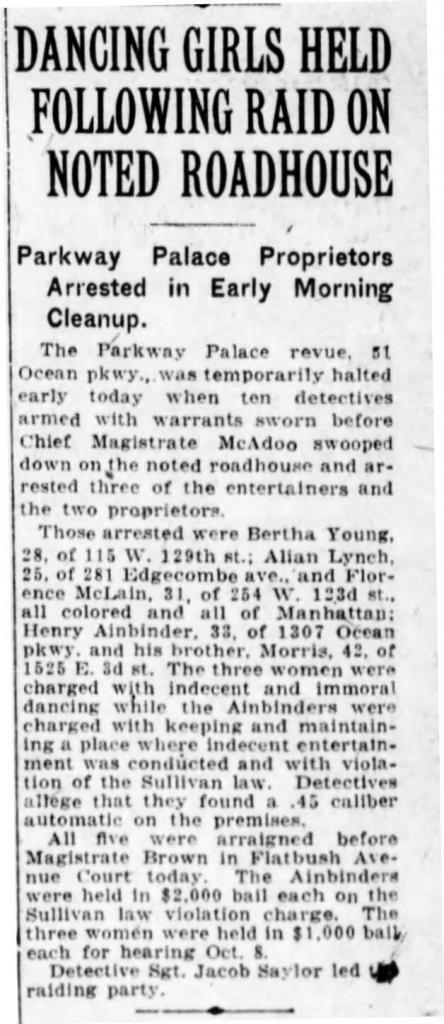
After the Orpheum job ended, Joe’s mom tried the equivalent of a “Hail Mary Pass” and enrolled him at a Dental Institute in Brooklyn. St. John was still a teen, she reminded him. When he graduated, he’d have the necessary skills to enter the world of Mechanical Dentistry, building bridges and sets of false teeth for the dentally challenged. Joe suppressed his stubborn streak and agreed to give the dental game a spin. He was at the Institute during the day and the Parkway Palace at night. The Parkway was a danceteria that featured a floor show. It was controlled by noted mobster Charles “Lucky” Luciano. “I worked at several mob places,” Joe remembered. “Gangsters would hire black bands because there was no chance of infiltration by Federal Agents. The Government refused to hire African Americans.”
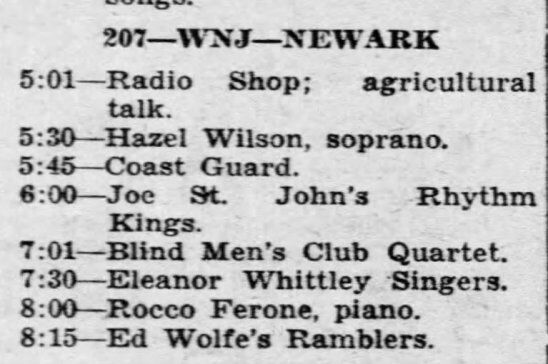
“After I left the Parkway Palace,” Joe continues, “I played at Billy Shaw’s night club in Hartford, Connecticut. I lived in New Haven.” Joe’s career was headed on an upward trajectory. Joe’s spell in the Dental lab ended before his Parkway gig.
One night in 1930, Joe was playing with the Keystone Jazz Band in Hartford, Connecticut. Earle Howard, a renowned bandleader who worked around the Northeast, was present. Howard was preparing for his Summer Tour of New England ballrooms, and he needed a few good men. Impressed with St. John’s musicianship and self-assurance, he offered him the tenor chair. Joe accepted the offer. “We toured the ballrooms in New England, all of the states, in 1930,” remembered Joe.
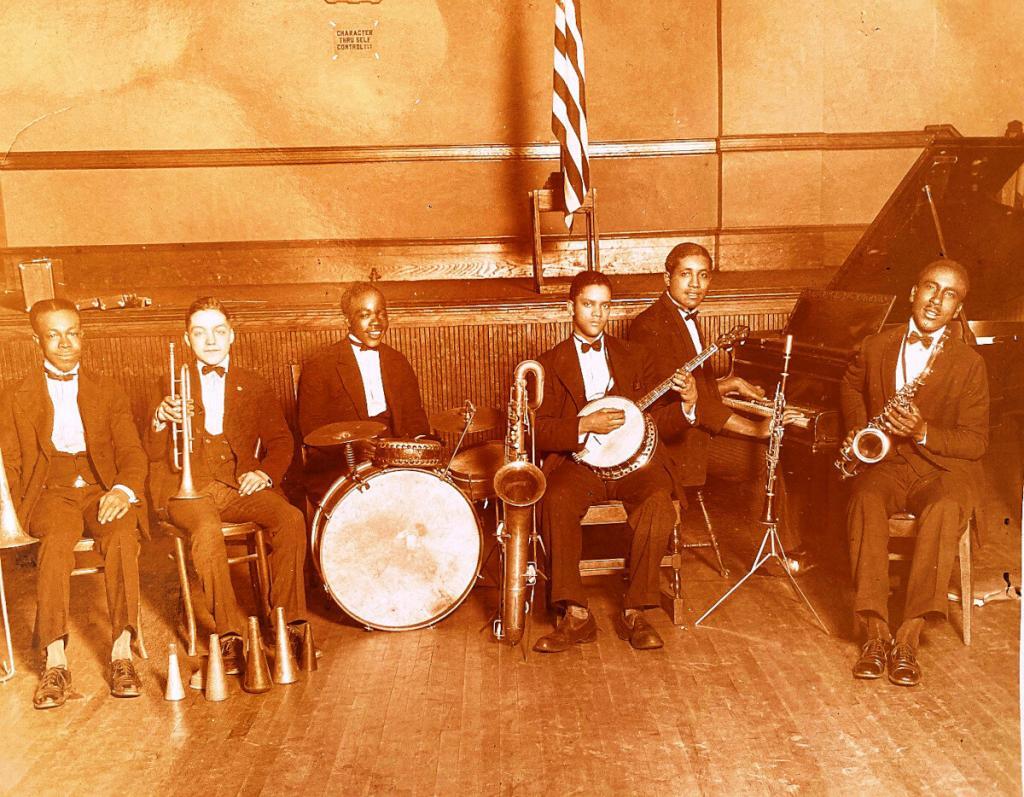
Howard, too, recalled the 1930 tour, as he told David Griffiths.[1]
“At that time, the Shribman Brothers, Charles and Cy, were the biggest bookers of bands in New England. They booked everything: Paul Whiteman, Fletcher Henderson, McKinney’s Cotton Pickers, Rudy Vallee, Casa Loma Orchestra, etc.”
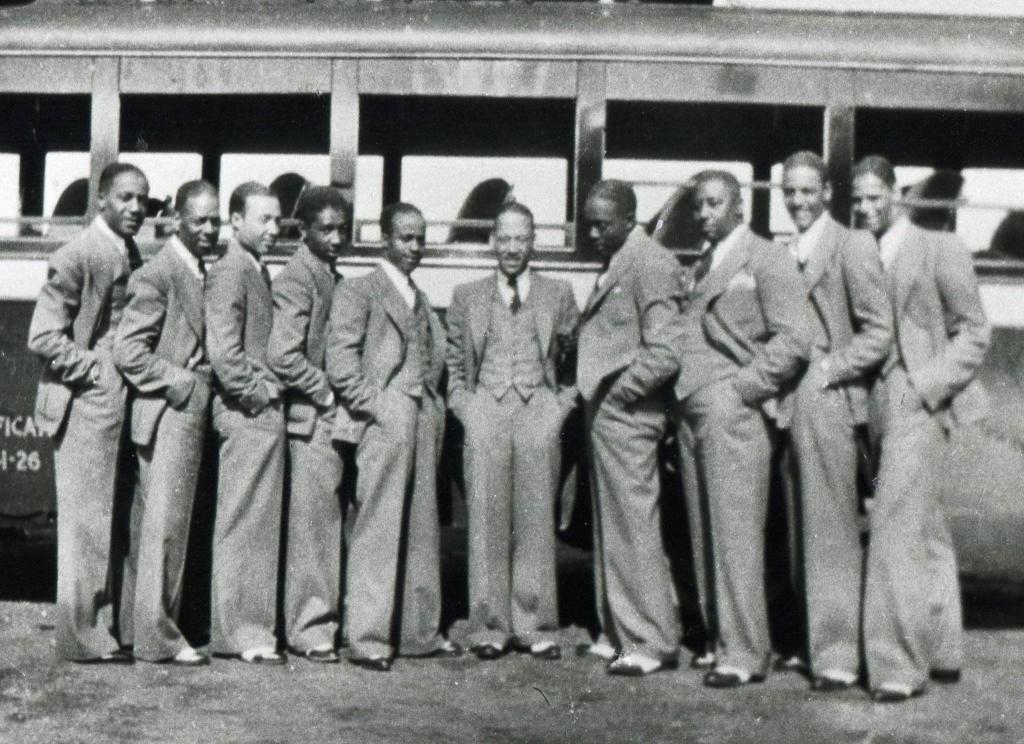
Howard’s band had the following personnel at the beginning[2]:
Johnny Muse, Harold Whittington (tp); George Robinson (tb); Carl Frye (as); Larry Ringold (as, ts, tp); Joe St. John (ts); Earle Howard (p, ldr); Arnold Canty (g); Jesse? (b); Dusty Neal (dms). May-December 1930
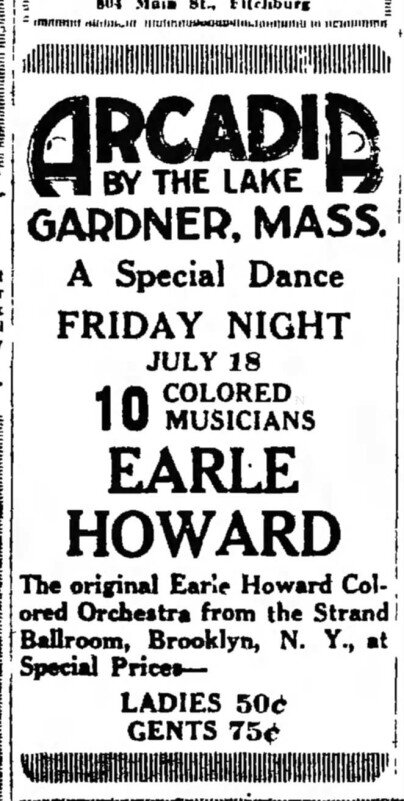 This was a slightly extended tour, as they ended up at a Boston ballroom for six months. St. John used his downtime to teach himself arranging. He would bring completed charts to rehearsals and let the musicians try them out. Many of Joe’s charts were incorporated into Howard’s band book. “After the New England tour,” St. John continues, “Earle Howard went into the Tango Palace.” Joe had been with the Howard band less than a year, but he was getting restless. “I sat on the end,” he sighed. “I would watch people passing. I got really bored sometimes.” Joe had bigger ambitions, and an opportunity soon came his way. He was asked by a gentleman known only as “Big Man” to front a band whose leader had skipped town with their charts – and their payroll. “I left Earle Howard to take the leadership of a ten-piece band in Newark,” he remembered. “They had a job at the Savoy coming up and needed a library.”
This was a slightly extended tour, as they ended up at a Boston ballroom for six months. St. John used his downtime to teach himself arranging. He would bring completed charts to rehearsals and let the musicians try them out. Many of Joe’s charts were incorporated into Howard’s band book. “After the New England tour,” St. John continues, “Earle Howard went into the Tango Palace.” Joe had been with the Howard band less than a year, but he was getting restless. “I sat on the end,” he sighed. “I would watch people passing. I got really bored sometimes.” Joe had bigger ambitions, and an opportunity soon came his way. He was asked by a gentleman known only as “Big Man” to front a band whose leader had skipped town with their charts – and their payroll. “I left Earle Howard to take the leadership of a ten-piece band in Newark,” he remembered. “They had a job at the Savoy coming up and needed a library.”
The Savoy job went well. St. John was attracting attention, and not only from the dancing public. Joe liked the ladies, and he told us he married young. His first wife was Madeline Burner. They lived at her family home in Newark in 1930 when she was twenty-one and St. John twenty-two. St. John’s home base varied from Newark to Ansonia to Manhattan. Once he established his orchestra, he spent more time in N.Y.C. and less in Newark, which impacted his marriage. The call of the jam session was too strong for him to resist.
“There were great jam sessions after hours in the 20’s and 30’s,” said Joe, smiling. “One of the main spots was the 101 Club in Harlem. We would blow all night. That is where I met every jazz musician in N.Y., Black and white.”
–Joe St. John
Joe loved the life of a musician. To him, this meant alcohol-fueled jam sessions, practicing his horn, writing music for his band, lookin’ sharp on the bandstand, and creating beautiful notes and tones with his saxophone.
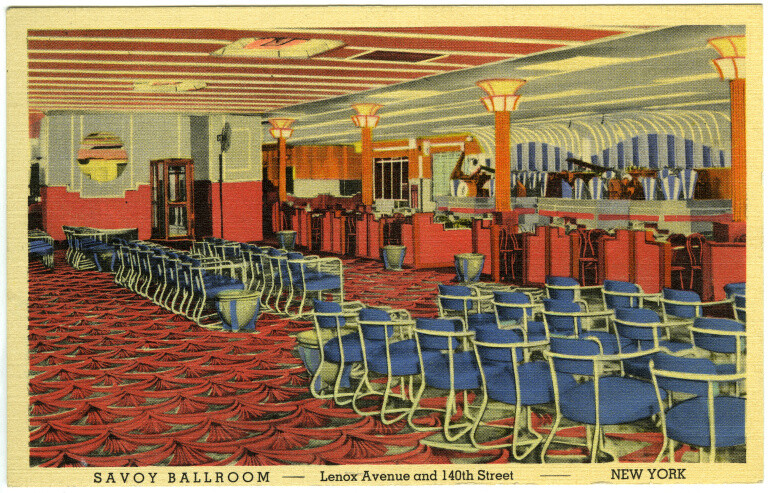
When the Stock Market crashed in 1929, the shock waves didn’t hit the lower rungs of the entertainment business for a couple of years. Not everybody in Manhattan was unemployed, which kept St. John’s band working, primarily in white venues.
In 1931, Joe’s orchestra worked at the Lyceum Ballroom in New York. “We played four nights a week at the Lyceum. We were the house band. Every week a guest band played four nights. We played a half hour, the guest band a half hour. Duke Ellington, Cab Calloway, and King Oliver were some of the guest bands.” Life was going well for Joe St. John. He managed to carve a niche for himself in the swiftly moving N.Y. music milieu.
The Lyceum Ballroom job finished in 1933, the worst year of the Great Depression. 20% unemployment. But rich folk in Manhattan kept dancing. His band found work at several white ballrooms, verifying the Joe St. John Orchestra had something folks wanted. “We also played four one-night stands at the Savoy Ballroom,” he added.
Trombonist Clyde Bernhardt heard Joe’s band and confirmed some of St. John’s itinerary. “he played a lot of hotel jobs for white people. The hotels would have two bands – one Black, and one white. They also played the Savoy when they’d bring in a second band.”[3]
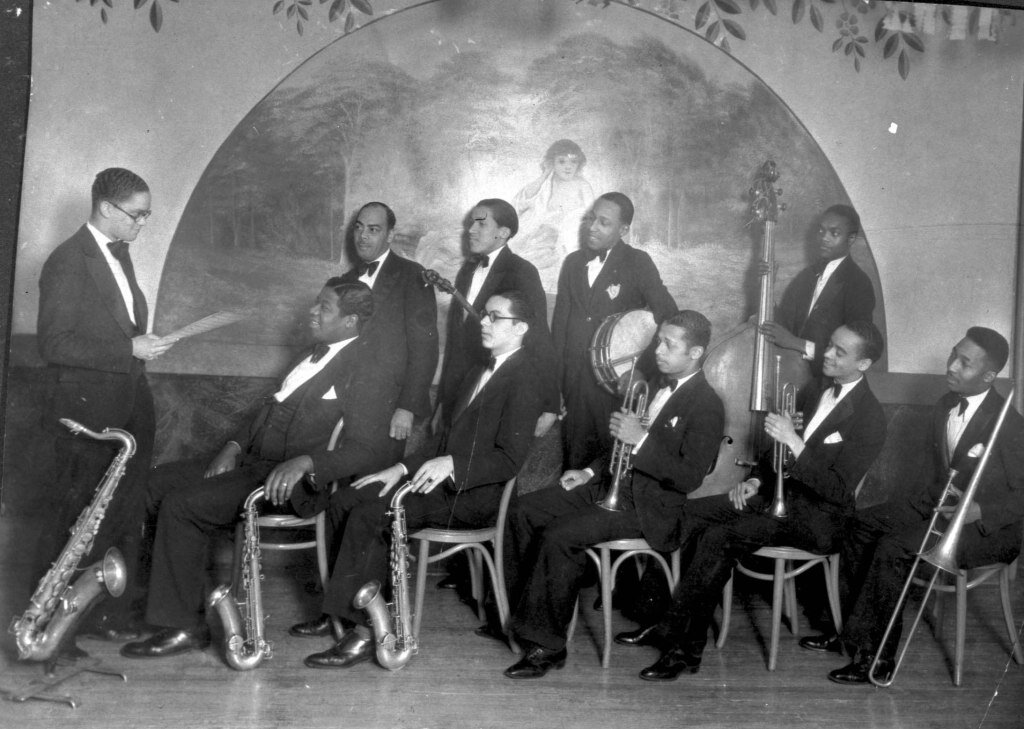
By age twenty-five, Joe’s marriage was on the rocks. Joe didn’t elaborate, but unless Madeline was a jazz supporter, she probably expected to have a husband who was ready and available – and home. Meanwhile, Joe was living the High Life in Manhattan. He’d met another woman, Edna Howard, while working at the Lyceum Ballroom around 1930. Edna was Joe’s Soulmate. He was sure she was: She’d requested “Rocking Chair,” which Joe liked to play. They stayed together until Joe passed. They loved each other, a great deal. “They never married,” stated Elenore, one of Norris’ Grand-daughters. St. John may not have divorced Burner. Three years later, St. John became embroiled in a conflict with Madeline, one that turned Joe’s life topsy-turvy. He no longer felt safe in New York City. He must quickly leave Manhattan on the Q.T. He would send for Edna and her teen daughter Patricia once he was settled. Joe didn’t plan a move to Detroit. It just worked out that way. As he recalled,
“My sister’s husband, [James Churchman], a mortician, had to come to Detroit on business. He knew people in Detroit. We planned to stay overnight with them and then go to Chicago. I had no plans to stay in Detroit.”
Inevitably, St. John ended up in a jam session at a night club in Paradise Valley, Detroit’s Black business and culture heartbeat. He was welcomed, and word quickly spread about his playing.
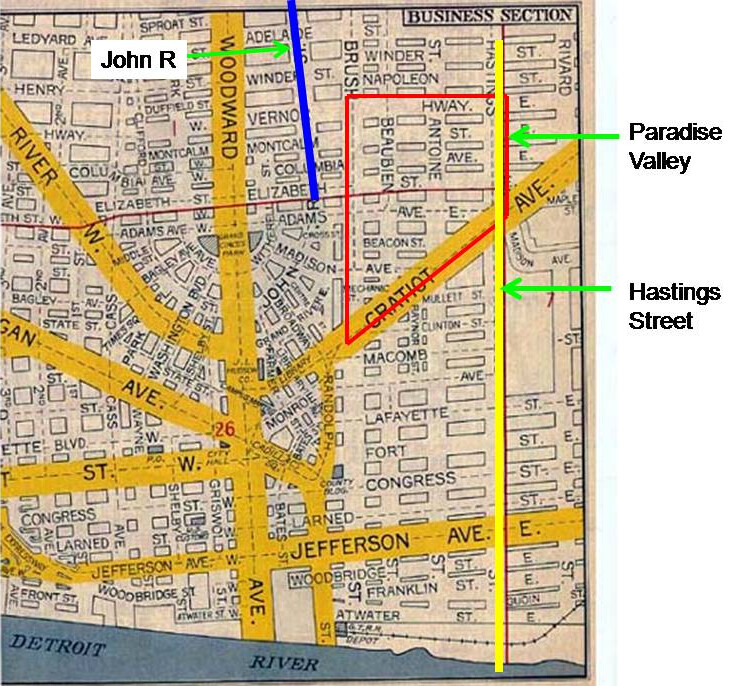
“The musicians seemed to like my playing,” he smiled. “They could not get over it. I was from New York City, after all! They told me to be at the Band Box tomorrow night. There were a lot of musicians there. We had a good old-fashioned ‘cutting contest.’”
The Band Box was a musician’s hangout. It was a ‘clearing house’ for gigs and a location for serious jam sessions. Joe claimed victory at that session, but more important he gained respect from the other participants. He felt welcomed into Detroit’s African American community.
“Next day, I had a gig,” Joe continued, “Three days after that, I had a steady engagement playing at Herbie’s Black Cat, a white spot with a Black band. It lasted for several months.” Joe felt comfortable in Detroit despite the racism and segregation. There were jobs and jam sessions and decent wages, even for a Black man. A musician could live on the money he earned.
Moving to a city with twenty-plus percent unemployment might not seem to be a smart move. Detroit took the first body blows of the Great Depression, with the demise of the many smaller auto car companies within its borders. Ironically, that decade saw the rise of Paradise Valley and the birth of many new clubs. Blacks made up 8% of the 250,000 souls within Detroit’s borders. Our research turned up seven jazz spots for the 1920s, but ten were were added in the following decade. All were in Paradise Valley. Most were owned by African Americans.
Meanwhile, Churchman had gone to Chicago. Joe never again saw him and never returned to Newark, not even for his mother’s funeral. Joseph Robert St. John vanished. In his place was “Joe Norris.” My research couldn’t confirm a legal name change, or how he came up with “Norris”. Nobody in Detroit knew his secret, save for his Detroit family.[4]
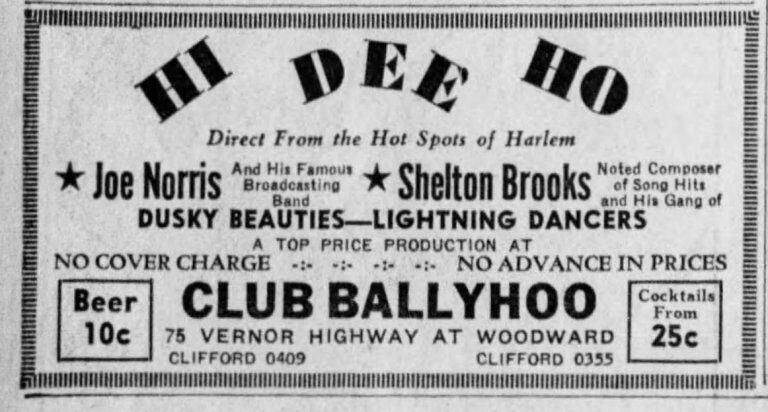
Norris got a room in a Hotel on St. Antoine, and it wasn’t long before he got the chance to lead & arrange for an eleven-piece band whose leader had skipped town with the payroll, an unfortunate (and not isolated) occurrence. The bandsmen, impressed with Norris’ talent and creds, elected him their leader. “We played at the Dance Box in Flint and then in the Ballyhoo Club in Detroit,” he noted.
The Ballyhoo Club got Joe a mention in the Detroit Tribune. By this time Joe Norris was a member of the American Federation of Musicians (A.F.M.) Local 5 in Detroit.[5] According to Norris, he was registered with New York City Local 802 as a “bandleader,” and so had the same status in Flint. Norris said there were two engagements available for Black bands, and he got the job at Club Frontenac. It lasted sixteen months. Club Frontenac was situated on Monroe Street, downtown. It had a white marble arch façade, and the band wore matching white suits, something noted in the Detroit Tribune.
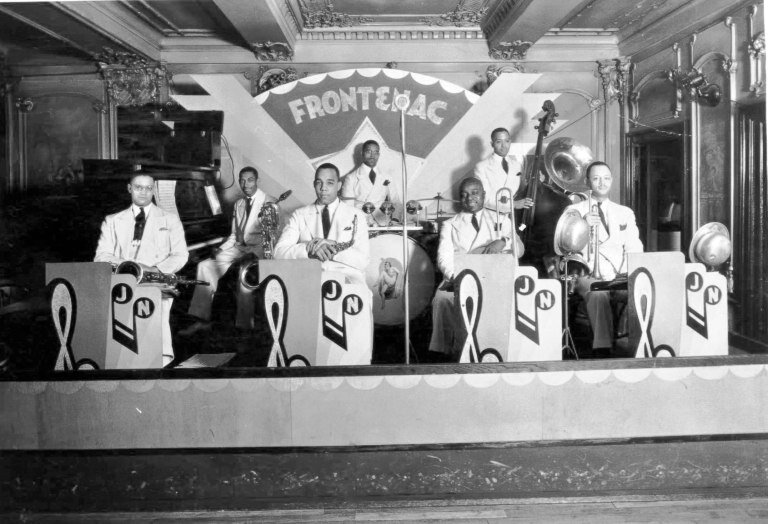
“They had female impersonators,” Joe remembered. “We played for floor shows and dancing, four nights a week.”
Once he settled into Detroit’s tempo, Joe moved into a single-family dwelling at 1018 Plum Street, on the near West side. He sent for Edna and Patricia. The dwelling served as a de facto rehearsal space and launching pad for late-night jam sessions. These were a source of embarrassment to his daughter Patricia, as the music sometimes got too loud, which brought the cops.
Norris counted many friends in his music circle. Some, like bassist Al Martin, became lifelong friends. Al graduated High School in 1943. His first job was with Joe. They worked together for years. “One of the top bassists in Detroit,” Joe declared. “Al has perfect pitch, can read at sight, always plays correct changes. Edna, Al and I used to spend many days at the Racetrack!” Both men laughed heartily at their memories. It was Al who introduced us to Joe.
Trumpeter James “Buster” Baker, an obscure figure from Detroit’s musical past, was another friend.[6] “When we had ‘cutting contests’ in the Rhythm Club and Band Box, Buster was my main opponent…he and (trumpeter) Charlie Moore were the biggest challenge for all of us,” Joe claimed. “We were fast on execution and never missed a change,” said Joe, speaking of Baker and himself. “We really enjoyed ourselves…. Musicians in those days loved music and proved it. Mediocrity was unknown.”
One thing Joe brought from Manhattan was his New York attitude. Saxophonist Frank “Ditto” Perry jammed with Joe several times. “He could play,” Perry said, “and he thought he was the best tenor player in the world, really.” [7]
Joe boasted that if any Detroit tenor player beat him, he’d quit playing. Yusef Lateef (William Evans, at that time) tried one night, “but he didn’t make it,” according to Joe. Joe Jammed with Lester Young three or four times. Once, in a tenor battle, only Joe and Pres remained. “Lester played thirty choruses on “I Got Rhythm” and never doubled a riff,” Norris remembered. “I lost that one.”
When the Japanese Empire attacked the U.S. Navy base at Pearl Harbor in December 1941, life in America changed. World War II dealt a major blow to the entertainment industry. Selective Service call-ups decimated big bands. The rationing of Gasoline, the outright ban on buying Tires and Shellac, and travel limitations put most swing orchestras out of business. These difficulties affected Black musicians & bandleaders more than their white brethren. Top shelf white bands such as trumpeter Harry James’s outfit, simply arranged to play in Manhattan hotels for extended engagements. This option was not open to Black bands.
The War brought prosperity back to Detroit. The many factories devoted to auto manufacturing were converted to tank, jeep, and aircraft production. Detroit was dubbed “The Arsenal Of Democracy.” There was a fresh influx of single men into Detroit to do War Work. The new jobs created disposable income, which meant there was money to spend on entertainment, which benefited Local 5 members and music venues. This new situation also begat a housing shortage, especially for African Americans, who were forbidden from buying property in most areas of the city. The lack of decent, affordable housing was a significant cause of Detroit’s 1943 race riot.
World War II created turmoil, which affected culture, music, and Jazz. Just before and during World War II, young Black musicians in Manhattan developed a tricky music that required greater knowledge of music theory than had swing. To paraphrase Bebop oracle Ira Gitler,
The early 1940s was a time of experimentation in jazz, not in a laboratory but in the jam session. Younger musicians wanted an escape from the strictures of big bands – limited solo space, arrangements repeated night after night – and they came up with fresh sounds which by 1945 had congealed into what the music press dubbed “Bebop.” This caused a split between musicians along generation lines. While some older guys (notably, Coleman Hawkins) listened carefully and encouraged their younger colleagues, most turned a deaf ear.[8]
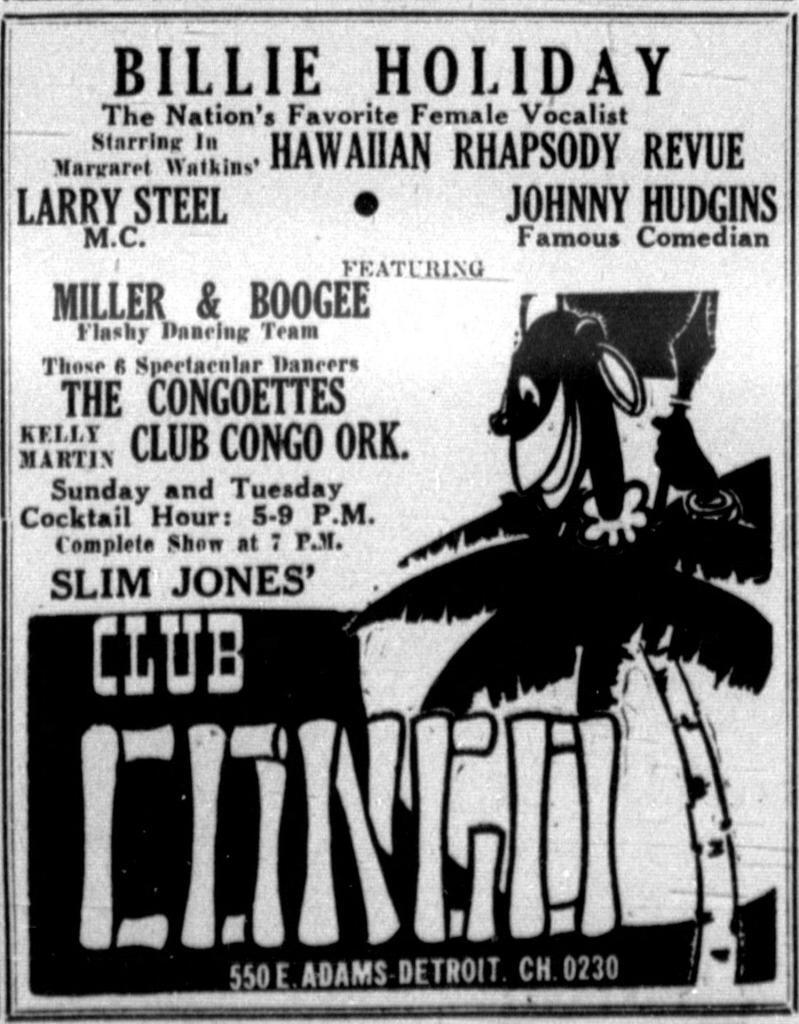
Detroit had similar younger players, like tenor saxmen Wardell Gray and Teddy Edwards, plus trumpeter Howard McGhee, who infused the new music into established Detroit bands like the Club Congo Orchestra. Young musicians saw themselves as ‘artists’ and not ‘entertainers.’ Bebop threatened comfort zones and strengthened the bridge between politics and music. It was an early step forward for the nascent Civil Rights Movement. It would take twenty more years before the Civil Rights Act passed Congress and was signed into law.[9]
Bebop turned up in Detroit in the form of trumpeter Dizzy Gillespie in a March 11, 1945 concert at the Shubert-Lafayette Theater. It was presented by WJLB radio host Bill Randle, a strong proponent of Detroit jazz. Joe Norris got second billing and participated in two more of Randle’s concerts. The concerts were well-attended and got rave reviews in the Black press.
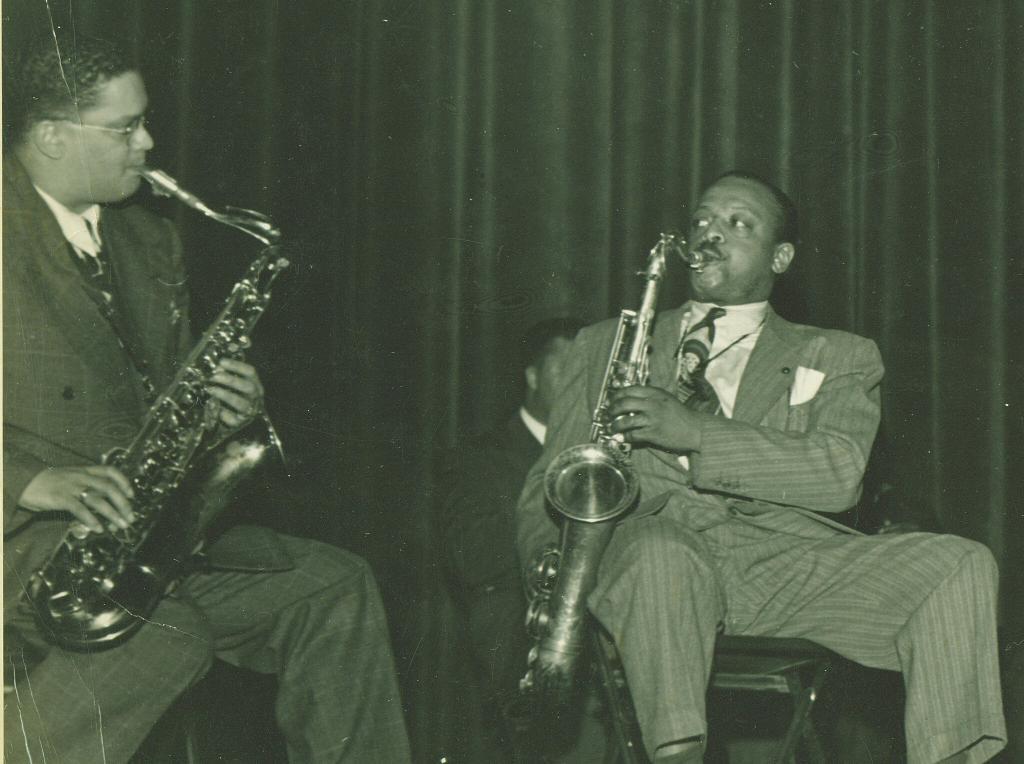
Joe and Ben Webster face off.
The technical demands of Bebop cut out those musicians who could not adapt rhythmically. It was an evolution, but because of the recording ban there were few audible stepping-stones for listeners to follow. Younger musicians who played Bebop became the Stars of Today.
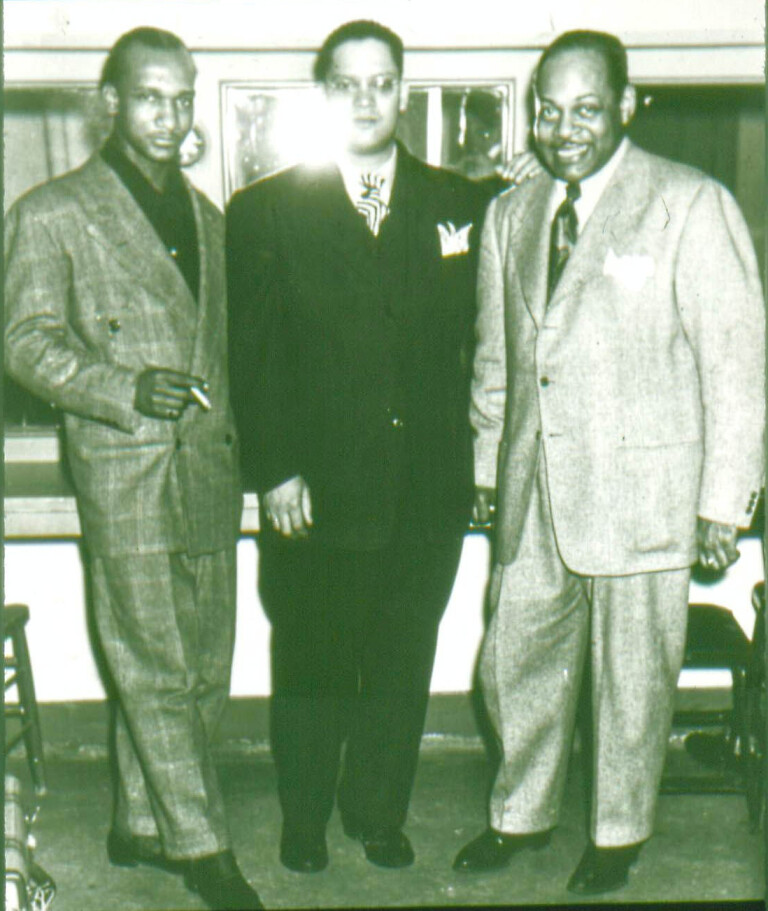
At the same time, New Orleans jazz was experiencing a revival, spurred by West Coast jazz devotees. Musicians from the music’s early days were identified and located. Many were put front and center before the public to play an approximation of the music from their youth. This was dubbed “trad jazz” in the music mags, who pitted one group against the other in an effort to increase circulation. Between these two factions was a kind of no-man’s land, where “Mainstream” players, who populated big bands were banished. Public tastes had changed, and their services were no longer wanted.
The constant in all of this was, The Blues, in all its forms and fashions. Recordings by Black artists, (first referred to as, “Race Artists”) were now collated as “Rhythm ‘n Blues” in Billboard Magazine beginning in June 1948, replacing the “Race Records” category. Detroit had several small groups which Bjorn and I called “Jump Bands” that featured a strong alto or tenor saxophonist, pianist, and 4/4 rhythm with a backbeat. Nationally, small groups (like the ensemble headed by alto ace Louis Jordan) took the spotlight. Jordan’s earthy, jivey music mix was just what African Americans wanted. Many younger musicians, e.g., John Coltrane and Jimmy Heath, worked in Jump Bands when Modern Jazz jobs were scarce.
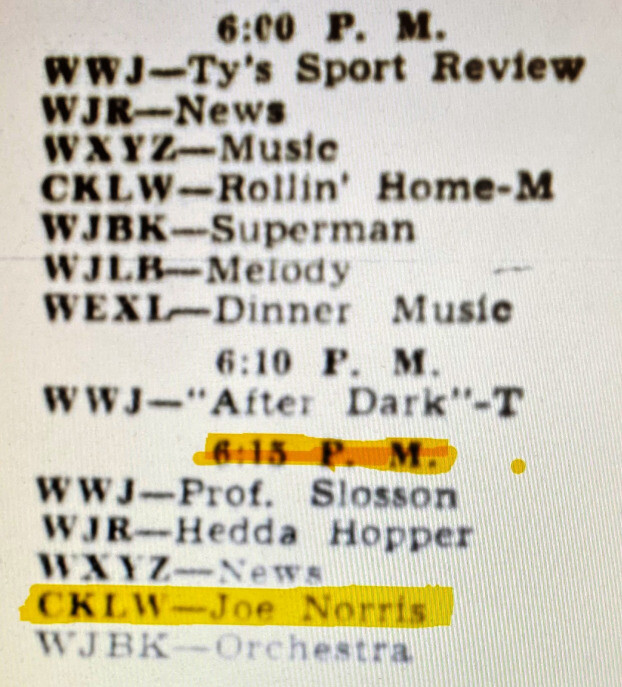
Not just small groups saw the rhythmic light. A few big bands hit pay dirt, too. Lionel Hampton, Buddy Johnson, Count Basie, all shifted into twelve-bar mode and ramped up the backbeat, featuring a tenor sax-man who whooped and shouted like a born again Preacher (ref. Hampton’s “Flying Home” with Illinois Jacquet). Indeed, Jacquet’s solo on Flying Home created jobs for saxophonists, as in J.A.T.P. tours, which featured “sax battles” at certain concerts.
There were a couple of career paths for a musician such as Joe Norris. He could morph into a “Honker and Shouter,” walking the bar and wailing at full throttle. Or, he might retool his style and join the Bebop crowd. Norris was a superb musician; clearly, he had the chops to adapt, and the tenor sax was an important instrument in BeBop. Joe’s idol, Coleman Hawkins, didn’t develop a new rhythmic sense, but he could mix in. Joe signaled his intention in a 1945 interview with columnist Lou Crampton.
“Last week in an interview with the Michigan Chronicle, Norris expressed a desire to wage a battle of music someday with some of the country’s best small band combinations. ‘We’ll soon be ready to compete against such bands as John Kirby and others.’ Meanwhile, Norris’ band is arranging old tunes and writing new ones…”[10]
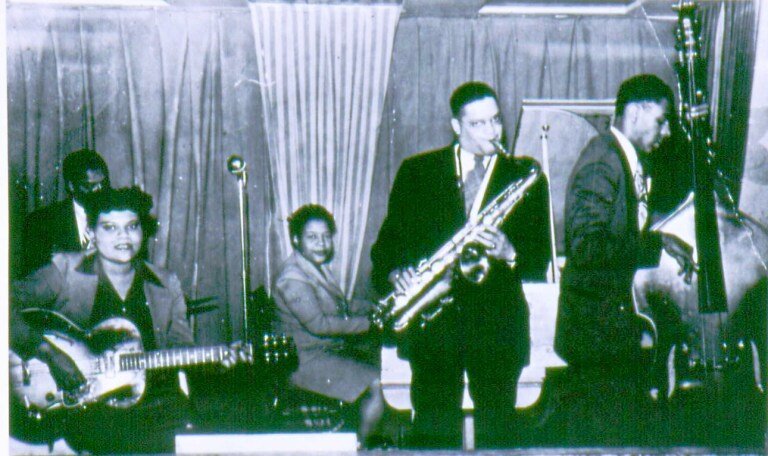
John Kirby’s band was brilliant, a cutting-edge sextet – in 1938. By 1945, not so much. Joe was a ripe thirty-seven years old in 1945 and already had a sound and identity.
That was a shame, according to trumpeter Joe Leach, a young man fresh on the scene in 1945. Leach and Norris were friends. Leach thought highly of Joe’s playing and didn’t understand his resentment.
“It was during this period (1945) that bop had just appeared on the horizon and Joe, instead of listening and adapting and learning, opposed the new music bitterly, personalized his bitterness, and extended it towards the younger players who were changing towards the new direction. Too bad. He had more talent than most of the folks he resented and could have blown them all away.”[11]
Joe’s scorn of Bebop doesn’t marry up with his 1948 recordings for the Paradise label. His two compositions, Dizzy Dazzy and Swing Teaser sound right in line with transitional small group swing recordings, seasoned with a taste of Bebop. It is as far as Norris would, or could, go.
Metronome writer Barry Ulanov paid a visit to Detroit in 1946,[12] and Norris was mentioned in his nice write-up which included a photo taken at Randall’s D.I.A. concert. Ulanov surveyed Detroit’s Nightclub scene, stopped at Club Sudan and heard Bebop coming from the horns of younger players. He found it “refreshing.” Norris’ popularity remained solid, as noted in a 1947 Chronicle note: “Joe Norris and his Quartette set a record for his appearance at Sportree’s Music Bar for seven weeks…” Joe placed third on tenor saxophone in the 1947 Detroit Tribune readers’ poll. Musicians took little notice of these Polls, but they provide a snapshot of the Detroit Jazz scene.
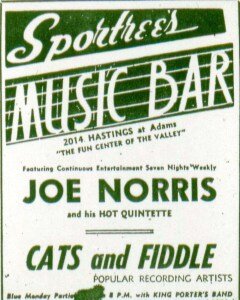
Joe’s comment about “major record labels not keeping offices in Detroit” had been true before WWII, but the post-war recording landscape was different. By 1947, Detroit had a few labels which focused on Detroit musicians. The shelf life of these labels wasn’t but a year or two, but Paradise Records waxed George Dawson’s Chocolateers, a seven-piece “pick-up” band assembled by guitarist Dawson. He needed arrangements and asked Norris to help. Joe arranged all six numbers and contributed two originals, to boot: Swing Teaser and Dizzy Dazzy. He solos on both numbers.
“Dizzy Dazzy” from George Dawson’s Chocolateers c1947-48 session for Paradise Records.. Composed/arranged by Joe“Swing Teaser”, as above.
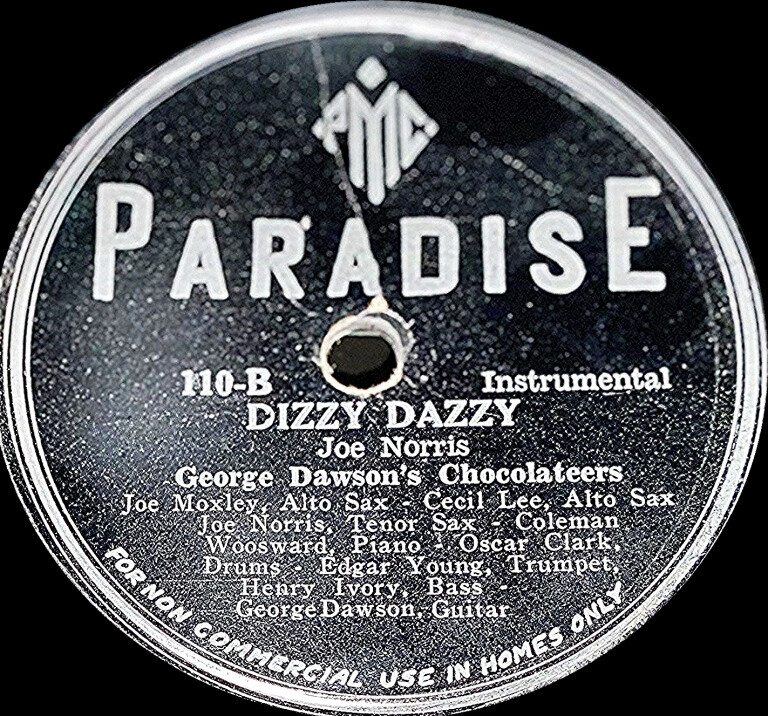
By 1949, Bebop had peaked. No longer the “new thing,” It was being absorbed into mainstream culture. There were clubs that featured Bebop in cities containing a strong African American culture, notably in Manhattan, where Birdland opened its doors that year. In Detroit, Jazz followers went to clubs like the Blue Bird Inn, a West side Black neighborhood bar which evolved into Detroit’s house of Bebop, or Club Sudan, located in Paradise Valley. Anchored by pianist Willie Anderson’s Trio, sitting in was welcomed. Club Sudan was in the basement of the Norwood Hotel. Because it didn’t have a liquor license, future jazz stars such as Kenny Burrell could participate.
There were other changes in Detroit’s music scene, too. Rhythm n’ Blues had settled in, and it was big business. The center of Detroit’s Black entertainment district was shifting North to John R Street near Canfield Avenue (see Map). There, the Flame Show Bar and the Frolic Show Bar offered new shows weekly[13]. The Flame, which opened in 1949, became Detroit’s primary outlet for national Black entertainment. Singers like Billie Holiday and Johnny Ray worked at the Flame, as did vocal groups such as the Orioles and the Dominoes[14] There were floor shows, and the club was open seven days a week, with a matinee on Sundays. The Government slapped a twenty percent “entertainment tax” onto nighteries which allowed dancing. That prompted clubs like the Flame to dispense with their dance floors.
The Paradise Theater, part of the vaunted “Chitlin’ Circuit,” ended its ten-year run in 1951 and sat vacant for decades. Detroiters tend to split their city down Woodward Avenue. Blues and R&B clubs gravitated to the East side, Bebop to the West side.
As the 1940s ended, Joe’s drinking increased. Edna tried to make him stop. “Edna told me to quit drinking, or she would quit me,” he said, glumly. “I was getting $110 a week, at that time good money,[15] I drank up all of it.” “That’s the only thing I got upset with Joe about,” Al Martin chipped in. “His drinking.”
The 1950s marked the start of Detroit’s Golden Jazz Age. Many younger musicians, raised in a middle-class environment and fortified with a top-notch music education, took the jazz world by storm. For Joseph Robert St. John, a/k/a Joe Norris, the 1950s marked the end of his performing career. Joe’s last advertised gig in the Michigan Chronicle is from 1954. He got a job as an orderly/X-Ray Technician at Detroit Receiving Hospital that year, a job Joe kept for twenty-five years, long enough to earn a pension. “I hated every minute of it,” he said, a hard edge in his voice. “I hate it to this day.” Joe worked briefly for Pinkerton’s as a security guard. Edna got work at Henry Ford Hospital in the dietary department. She joined the Detroit chapter of the Congress On Racial Equality (C.O.R.E.), and may have held elected office. There are photographs of Edna at dinners and meetings, sometimes with Joe in tow.
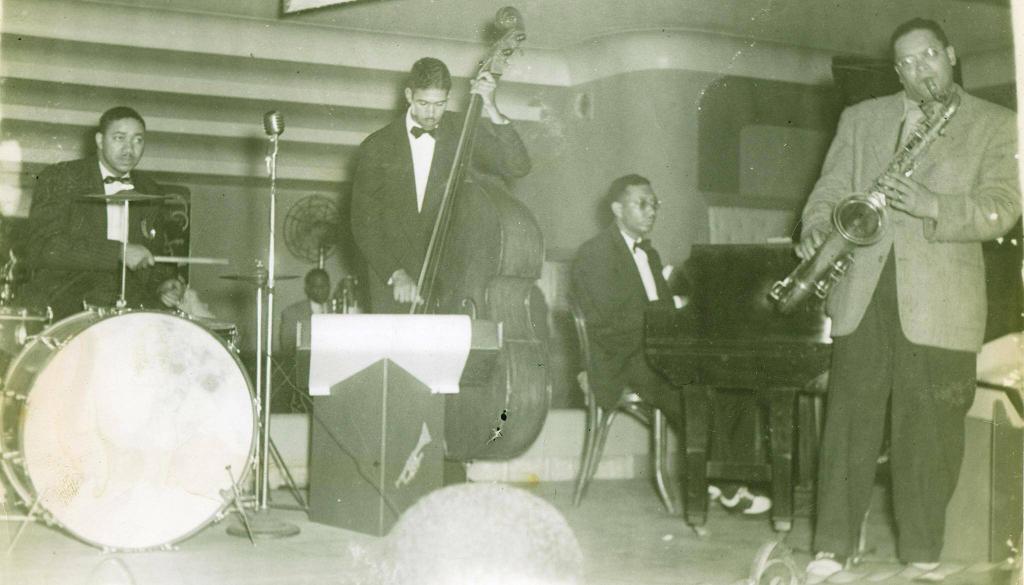
His Grand-daughter, Elenore, recalled hearing Joe play at a banquet in the 1960s, but that was a one-off. “Joe was under strict orders from his Doctor not to play,” she said. “Because the alcohol had caused internal bleeding. Playing his tenor could kill him.”
Joe’s creative spirit surfaced in different areas. He collected Butterflies, and owned hundreds of carefully mounted samples from around the world. Joe liked to remove a Butterfly from its cabinet and talk about it. He knew a great deal about each Butterfly. Norris had many books on Natural History and jazz, and 78rpm Fletcher Henderson records. There appears to be a link between jazz and cooking. Many musicians like to create in the kitchen, and Joe was one. “He was a really good cook,” his Granddaughter Audrey remembered. “He compiled a book of his recipes.”
Joe had an upright piano in his hobby room that was regularly tuned, and he would sometimes dip into his piano past and play for his Granddaughters. Norris had written a few dozen songs over the years. He’d also written letters to various publications about this or that topic. Joe had an acerbic comment about religion in Public Schools (he was very strongly against religion of any shade) published in the Detroit Free Press.[16]
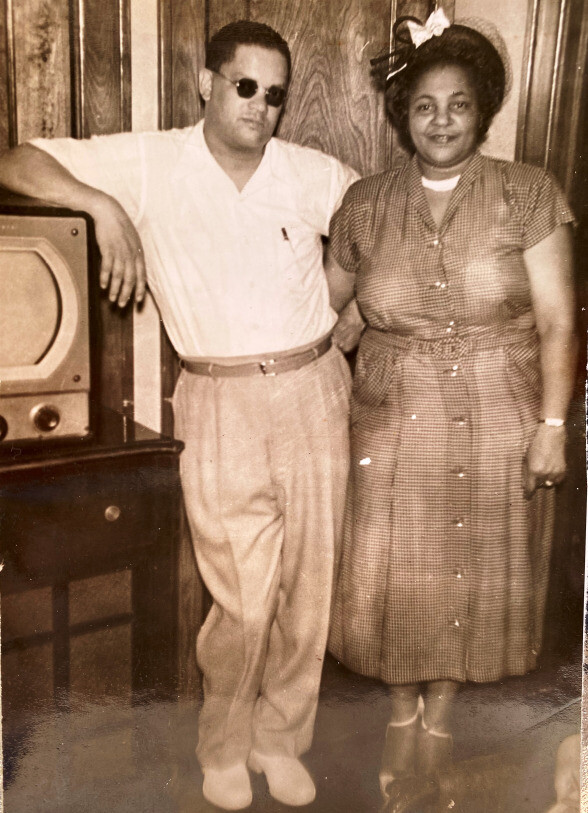
Joe and Edna had a tidy Bungalow on Hubbell Avenue, in Detroit, with a large fish tank (Joe liked saltwater tropicals) and a large shaggy dog whose name I forget. When Lars and I met Joe in 1988, he’d long since stopped playing his beloved saxophone. He was still packed with creative energy that was directed to hobbies. At one time Norris had “twenty-six aquariums,” according to Audrey. “He kept fish of all kinds.”
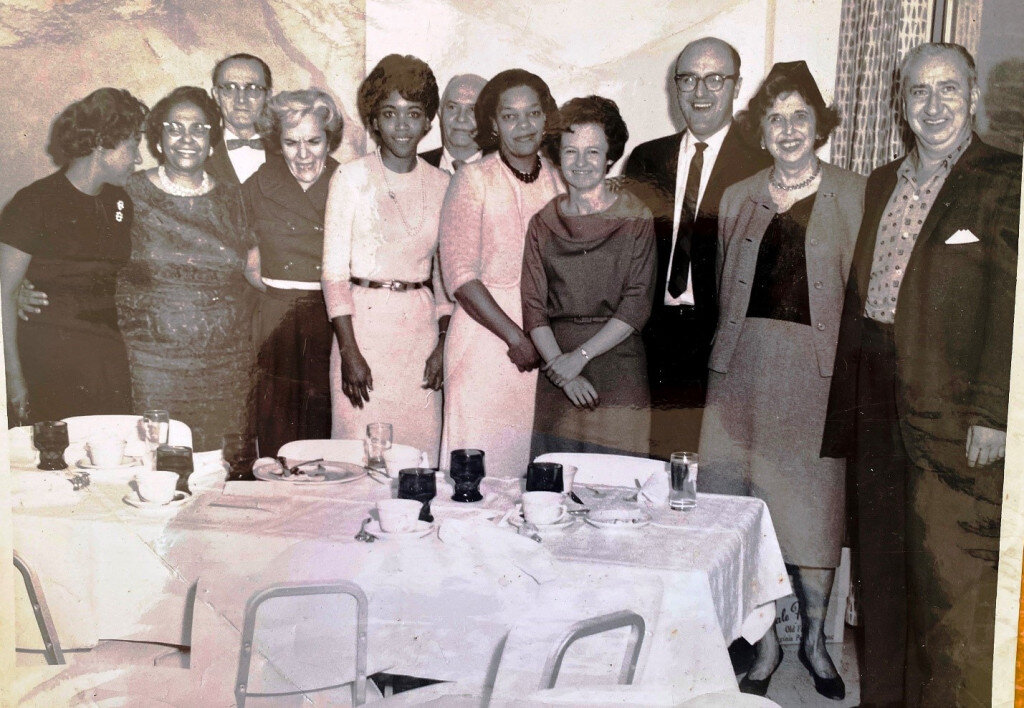
Joe was articulate, intelligent, and current on world affairs. Joe Norris was truthful. His recollections usually married up with Lars’ newspaper items. When Joe repeated a story, it didn’t change. He got around their house with the aid of a walker. Suffering with serious health issues, Norris continued his battle against alcoholism, a battle that began before he’d come to Detroit.
Joe was opinionated and argumentative. He enjoyed discussing a wide range of topics, especially jazz or natural history. Joe was a devout Atheist and would marshal a range of arguments against the existence of God.
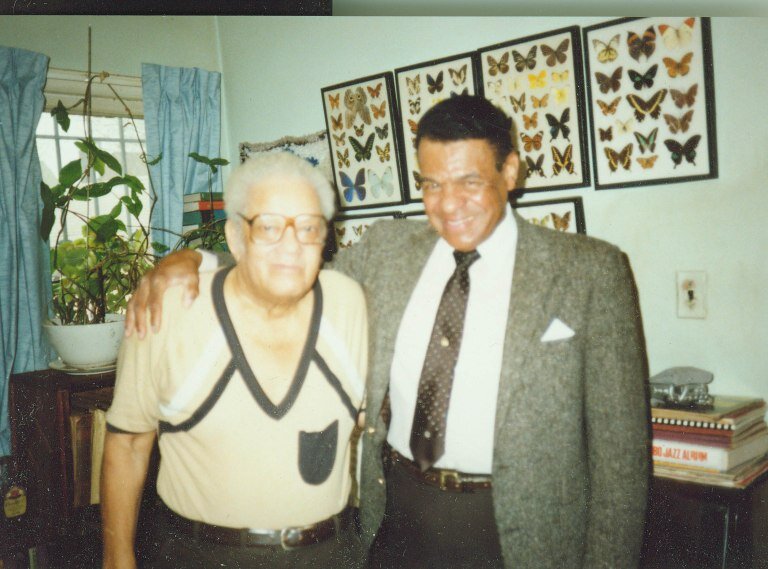
His foremost argument was, “If there is a God, why would he take away from me the one thing I love more than anything else?” Joe couldn’t separate his life as a musician from his alcoholism. When he reached for his tenor, a bottle of Scotch would soon appear. I engaged Joe on this topic but gave it up; there was no changing his position, or his beliefs. He’d destroyed most of his sheet music, music stands, and many of his records, in fits of despair.
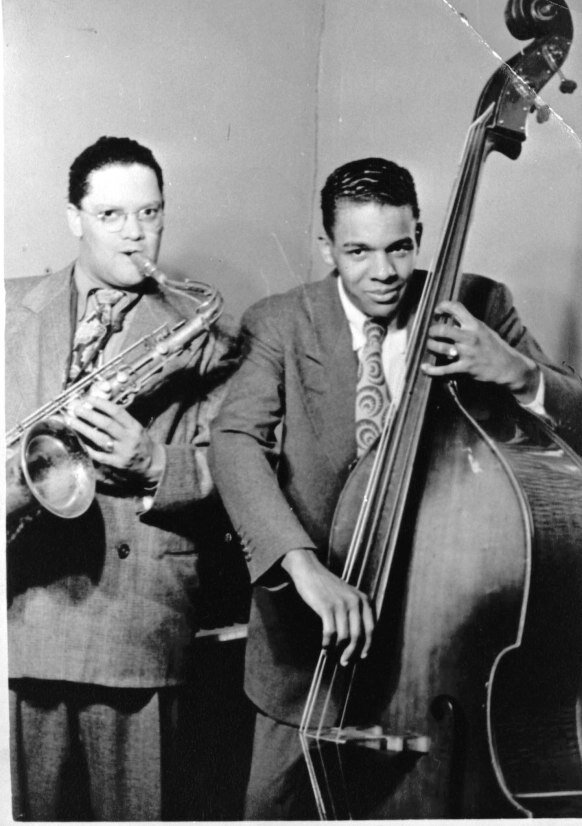
Joe had three step-granddaughters, Audrey, Elenore, and Kathy. They spent considerable time with Joe and Edna and they must have brought Joe some happiness. “He liked for us to come around,” Audrey remembered. The sisters are well-spoken and it’s likely Joe had a hand in their upbringing.
Joe would sometimes play a few Fletcher Henderson Orchestra 78’s, but he found it difficult listening to musicians he knew ‘back in the day’ because they were all dead. He enjoyed speaking of his wonderful career as a respected musician in New York and Detroit, two jazz cities.
Joe summed up his Detroit career thus:
“When I left N.Y.C. I lost my chance for national recognition. Recording company’s (sic) did not come to Detroit to record jazz combos. I could have accepted offers to join big bands, but why should I? I certainly had no intention of going on the road, especially down south. I was doing O.K. right here in Detroit.”
Unless specified, all quotes come from many interviews and conversations I had with Joe Norris, 1987-91, at his home in Detroit. The main interview was on March 15, 1987, with Lars Bjorn and Al Martin. His Step-Granddaughters, Audrey, Elenore, and Kathy, generously allowed me to copy their family photos. I spoke with them during 2020 either on the phone or in person.
End Notes:
- [1] Storyville 088, pp15-23, The Earl Howard Story, Griffiths, David. pp.15-28. Howard gave conflicting reports as to the tour dates and personnel in his 1953 interview with Kurt Mohr.
- [2] Personnel given by Howard to researcher Kurt Mohr in 1953.
- [3] Clyde E. B. Bernhardt, Sheldon Harris, I Remember: Eighty Years of Black Entertainment, Big Bands, and the Blues. University of Pennsylvania Press:1986
- [4] I stumbled upon it while researching personnel for Earle Howard’s band. I couldn’t find a tenor named “Joe Norris,” only a “Joe St. John.” Perhaps Joe had replaced St. John, or vice-versa? Joe looked sheepish and owned up but swore me to secrecy until after his death.
- [5] He became a member of Local 5 on May 29, 1935.
- [6] Baker played with McKinney’s Cotton Pickers around 1934, acc. to Chilton Who’s Who.
- [7] Frank “Ditto” Perry, interview, Lars Bjorn and Jim Gallert, Detroit, September 2, 1992.
- [8] Ira Gitler, Swing to Bop (New York: Oxford University Press, 1985)
- [9] President Lyndon Johnson signed the bill into law on June 2, 1964.
- [10] Michigan Chronicle, August 28, 1945.
- [11] Joe Leach email to Gallert, January 22, 2003.
- [12] Downbeat, June 1946.
- [13] Show Bars in Detroit had the bandstand located behind the bar. It was the same height as the bar.
- [14] A new crop of vocalists popped up, especially during the1948 musician’s Union strike[5]. Singers were not classed as “musicians,” and thus could record; many would become Stars.
- [15] $1,187.77 in 2020 USD
- [16] May 19, 1986.
Jim Gallert is a veteran Jazz broadcaster, Jazz Archelogist and writer. He produced & hosted Jazz programs for twenty-five years on WDET-FM (“Jazz Yesterday”, “Detroit Jazz Alive”) and WEMU-FM (“Swing City”). Gallert has been a Staff member for all 41 Detroit Jazz Festivals. He and Lars Bjorn produce and host presentations, panel discussions, interviews, and music performances in the Jazz Talk Tent at the Detroit Jazz Festival every Labor Day weekend in downtown Detroit. Jim and Lars have a Blog, www.detroitjazzhistory.com with features on Detroit musicians.
Lars Bjorn is a Professor Emeritus of Sociology at the University of Michigan-Dearborn and the author of (with Jim Gallert) Before Motown: A History of Jazz in Detroit, 1920-60 (University of Michigan Press, 2001). He is also the Editor of the SEMJA Update, the monthly newsletter of the Southeastern Michigan Jazz Association.
























